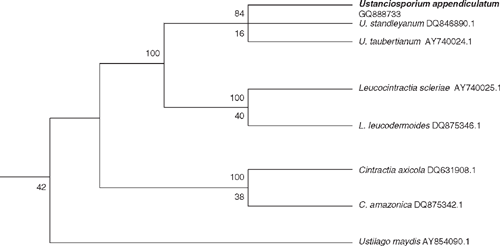First report of the smut fungus Ustanciosporium appendiculatum in Australia
R. G. Shivas A F , A. R. McTaggart B , M. J. Ryley C , T. Scharaschkin D and C. F. Gambley EA Plant Pathology Herbarium, Queensland Primary Industries and Fisheries, 80 Meiers Road, Indooroopilly, Qld 4068, Australia.
B Cooperative Research Centre for National Plant Biosecurity, c/- Plant Pathology Herbarium, Queensland Primary Industries and Fisheries, 80 Meiers Road, Indooroopilly, Qld 4068, Australia.
C Queensland Primary Industries and Fisheries, PO Box 102, Toowoomba, Qld 4350, Australia.
D School of Natural Resource Sciences, Queensland University of Technology, Brisbane, Qld 4001, Australia.
E Queensland Primary Industries and Fisheries, 80 Meiers Road, Indooroopilly, Qld 4068, Australia.
F Corresponding author. Email: roger.shivas@dpi.qld.gov.au
Australasian Plant Disease Notes 5(1) 17-18 https://doi.org/10.1071/DN10007
Submitted: 14 September 2009 Accepted: 2 February 2010 Published: 3 March 2010
Abstract
Ustanciosporium appendiculatum was collected on Rhynchospora exserta from northern Western Australia in May 2009. The identification is based on morphological and sequence data which are presented for the first time. This is the first report of this smut fungus outside North America. Rhynchospora exserta is a new host species for this smut fungus.
Rhynchospora is a genus of sedges (Cyperaceae) with ~250–300 species worldwide with most diversity in tropical America (Thomas et al. 2009). In Australia there are ~17 species (~5 species endemic) (Wilson 2009). Vánky and Shivas (2008) list three species of smut fungus on Rhynchospora spp. in Australia, viz. Cintractia amazonica Syd. & P. Syd., Leucocintractia scleriae (DC) M. Piepenbr., Begerow & Oberw. and Trichocintractia utriculicola (Henn.) M. Piepenbr. During a survey of smut fungi in northern Western Australia in May 2009 a smut fungus was collected on R. exserta unlike any known from Australia. A specimen was deposited as BRIP 52556. At the same location plants of R. exserta were also infected with Cintractia amazonica Syd. & P. Syd. (deposited as BRIP 52535).
The smut was identified as a member of Ustanciosporium by morphological and molecular methods. Morphologically it matched the description of U. appendiculatum M. Piepenbr., which characteristically has spores with two conspicuous appendages, one on each flattened side as illustrated by light microscopy (Fischer 1953; as Cintractia montagnei (Tul.) Mag.) and by scanning electron microscopy (Piepenbring 2000).
Worldwide there are ~25 species of Ustanciosporium, of which ~17 occur on Rhynchospora (Vánky 2006). Vánky (2006) noted that mixed infections of Ustanciosporium spp. on Rhynchospora were frequently found and that this had caused numerous taxonomic and nomenclatural problems. Vánky (2006) raised the possibility that the U. montagnei complex, to which U. appendiculatum belongs, may comprise several morphologically similar species. Further molecular studies may help resolve this.
DNA was extracted following the protocol of the Qiagen Puregene Extraction Kit and the ribosomal internal transcribed spacer (ITS) region was amplified by polymerase chain reaction using conditions and primers described in White et al. (1990). A DNA specimen of U. appendiculatum has been stored in the Biosecurity Bank (http://www.biosecuritybank.com/), and the ITS sequence has been deposited in GenBank (GQ888733).
This is the first report of U. appendiculatum outside North America. A brief description of the Australian specimen (BRIP 52556) follows.
U. appendiculatum M. Piepenbr., Nova Hedwigia 70: 331 (2000).
Type on Rhynchospora capitellata, USA, Massachusetts, Plymouth Co., Plymouth, small pond near Fearing Pond, 7 Aug. 1936, F.C. Seymour 4857 (as Cintractia montagnei), M; isotype in NY.
Sori in all the spikelets of an inflorescence, black, powdery. Spores subglobose, ellipsoidal, or irregularly polygonal, flattened in lateral view, 13.0–18.5 × 10–15 µm, reddish brown, foveolate, smooth in profile, with sporogenous wall material (appendages) attached opposingly on the two flattened sides; wall even, 0.7–1.0 µm thick. Appendages attached to the spores or detached from them, globose to subglobose, 4–8 × 4–7 µm, pale yellowish brown.
Material examined: On Rhynchospora exserta C.B. Clarke, Western Australia, 35 km N of Drysdale River Station, alt. ~377 m, 17 May 2009, A.R. McTaggart, V.L. Challinor, M.J. Ryley, C.F. Gambley, T. Scharaschkin, M.D.E. and R.G. Shivas, BRIP 52556 (Fig. 1).

|
A Basic Local Alginment Search Tool (BLAST) search of the ITS DNA sequence data obtained for Ustanciosporium appendiculatum revealed an 89% sequence identity with U. standleyanum (Zundel) M. Piepenbr. (DQ846890.1) over 92% query coverage, and 81% similarity to U. taubertianum (Henn.) M. Piepenbr. & Begerow (AY740024.1) over 97% query coverage.
Analysis of the ITS region of Ustanciosporium appendiculatum and some closely related taxa from GenBank in an exhaustive maximum parsimony search using Phylogenetic Analysis Using Parsimony (PAUP)* v4.0b4 yielded two trees of equal length. The topologies of these trees were similar to a maximum likelihood analysis using PAUP* v4.0b4. A consensus tree of the parsimony analysis is shown in Fig. 2. Ustanciosporium appendiculatum is sister to two other Ustanciosporium species for which sequence data are available.

|
Acknowledgments
ARM would like to acknowledge the support of the Cooperative Research Centre for National Plant Biosecurity, established and supported under the Australian Government’s Cooperative Research Centres Program.
Piepenbring M
(2000) The species of Cintractia s.l. (Ustilaginales, Basidiomycota). Nova Hedwigia 70, 289–372.

Thomas WW,
Araújo AC, Alves MV
(2009) A preliminary molecular phylogeny of the Rhynchosporeae (Cyperaceae). Botanical Review 75, 22–29.
| Crossref | GoogleScholarGoogle Scholar |

Vánky K
(2006) Taxonomic studies on Ustilaginomycetes – 26. Mycotaxon 95, 1–65.



